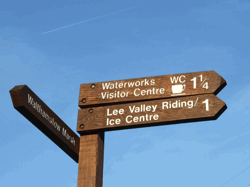 |
|
| An Ecological Assessment of Temple Mills |
|
| AN ECOLOGICAL ASSESSMENT OF TEMPLE MILLS |
| A report commisioned by The London Borough of Waltham Forest |
| London Ecology Unit |
| January 1992 |
| Naill Machin John Archer |
| London ecology Unit Director, Dr D A Goode Bedford House 125 Camden High Street, Camden Town, London NW1 7JR Telephone 071 267 7944 Facsimilie: O71 267 9334 |
| TEMPLE MILLS ECOLOGICAL ASSESSMENT |
| Introduction |
| 1.1 The London Ecology Unit was commissioned by the London Borough of Waltham Forest in November 1990 to undertake an ecological assessment of the Temple Mills area. This study forms part of a wider Environmental Assessment being drawn up on behalf of the Borough in relation to the proposed Leyton Relief Road. |
| 1.2 The Unit's brief was to produce a detailed assessment of the impact of development on the sites flora and fauna and to discuss mitigation measures for minimising any adverse impact. |
| Current Ecological Status. |
| 1.3 The Temple Mills area contains an extensive complex of wasteland habitats associated with abandoned railway marshalling yards and former gas board land. The vegetation contains elements of woodland, grassland, scrub, bare-ground and stream communities. The railway marshalling yards themselves support vegetation typical of immature wasteland. |
| 1.4 Major tracts of wasteland habitat are becoming a rare occurrence within London. Temple Mills Wasteland is recognised by the London Ecology Unit as a grade one Site of Borough Importance for nature conservation in its ecology handbook No.11 'Nature Conservation in Waltham Forest'. |
| Sources of Data. |
| 1.5 Data on the current ecological status of Temple Mills results from: |
| 1. The London Wildlife Habitat Survey. 1984. |
| 2. LEU visit to site for L B Waltham Forest, 6.10.89. |
| 3. LEU/LB Waltham Forest common bird census for the purposes of this report April - August 1991. |
| 4. LEU/LB Waltham Forest vegetation survey for the purposes of this report, 10.6.91 and 22.8.91. |
| Vegetation. |
| 1.6 The vegetation of the site is characterised by open wasteland communities grading into longer-established areas of young trees and scrub, with some limited patches of mature trees. The Dagenham Brook flows along the eastern boundary of the site. The distribution of vegetation on the site is as follows (refer to map 1): |
| a) Former Gas Board Site - Areas of bare concrete interspersed with well developed goat willow, sliver |
| birch and buddleia scrub. An area of neutral grassland is found to the south and a small patch of sycamore 'woodland' occurs in the north-eastern corner. |
| b) Dagenham Brook Corridor - A narrow corridor of dense bramble scrub and tall herb communities enclosing the brook. Some aquatic vegetation including fennel-leaved pondweed and a small patch of Prunus woodland. |
| c) Northern Marshalling Yards - An extensive area of ruderal wasteland communities with numerous young trees and patches of well developed scrub. Includes a small patch of woodland/ overgrown garden which contains mature trees (referred to as the 'hump'). |
| Southern Marshalling Yards - Characterised by less shrub and tree growth, primarily composed of low growing grasses and herbs typical of immature wasteland, including patches of viper's bugloss and extensive areas of St. John's wort. |
| Eastern Embankment - Contains the most mature vegetation on the site with thick hawthorn scrub and mature tree species, chiefly sycamore, goat willow, silver birch and eider. On the western edge of the slope the tall vegetation gradually merges into the shrub and ruderal communities of the northern and southern marshalling yards. |
| 1.7 Plants have been recorded by the London Natural History Society [2] in approximately 850, 2 x 2km grid squares ("tetrads") in London between 1965 and 1976. The Unit regards plants recorded in 15% or fewer of the tetrads within Greater London as being rare. The following plants recorded from Temple Mills come into this category: |
| a) Arenaria serpyllifolia (Thyme-leaved sandwort) |
| This species has been recorded from 11.25% of tetrads in the London area. It is a species of light soils and decaying walls and there are no records in Burton [2] for Waltham Forest or from its neighbouring east London Boroughs. A nationally common plant. |
| B) Chaenorhinum minus (Small toadflax) |
| This species has been recorded from 13% of tetrads in the London area. It is described by Burton as "a common plant in fields and gardens on the chalk south of London. To the west and north west it is abundant along some railways." There were no records from Waltham Forest and its neighbouring east London boroughs. Nationally a plant of arable land and waste places described as common in S. England. |
| COPYRIGHT LONDON ECOLOGY UNIT JANUARY 1992 CASE 1310 PAGE 2 |